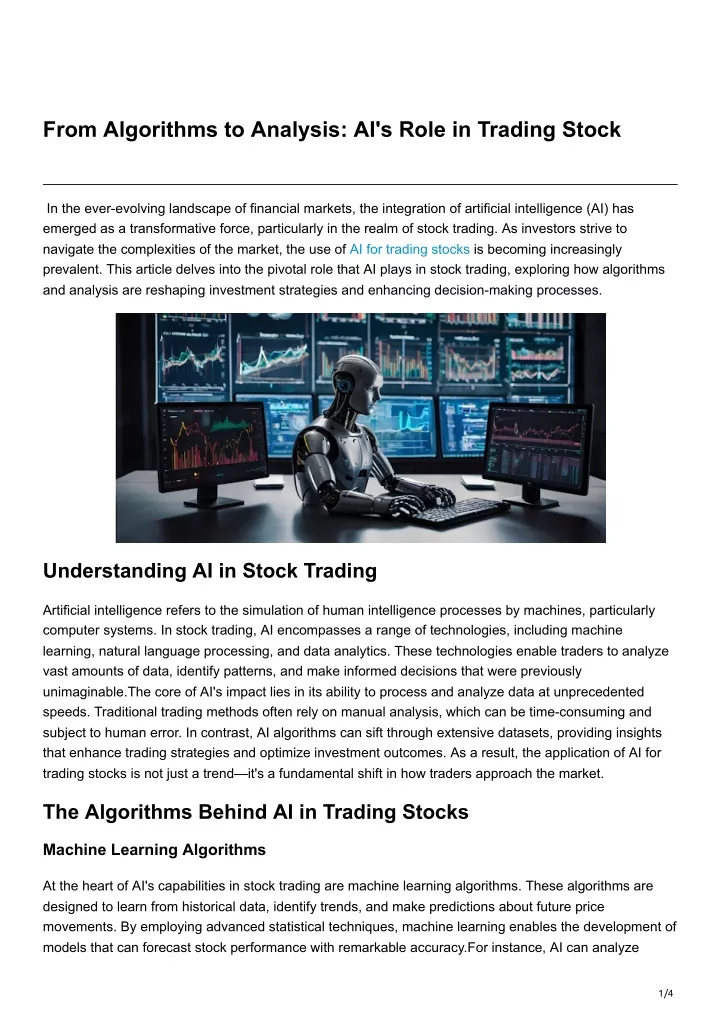In order to get accurate, reliable and useful insights, you need to test the AI models and machine learning (ML). Poorly designed or overhyped models can lead flawed predictions, and even financial losses. Here are the top 10 strategies for evaluating AI/ML models that are available on these platforms.
1. Understand the model's purpose and its approach
Clarity of goal: Decide the purpose of this model: Decide if it is for trading in the short term or long-term investment, risk analysis, sentiment analysis, etc.
Algorithm transparence: Check whether the platform discloses types of algorithms employed (e.g. Regression, Decision Trees, Neural Networks, Reinforcement Learning).
Customization. Determine whether the model can be adapted to be tailored to your trading strategy, or your risk tolerance.
2. Evaluation of Model Performance Metrics
Accuracy: Check the accuracy of the model's predictions and don't solely rely on this measure, since it could be misleading in the financial market.
Precision and recall: Assess whether the model is able to identify real positives, e.g. correctly predicted price changes.
Risk-adjusted Returns: Check if a model's predictions result in profitable trades taking risk into account (e.g. Sharpe or Sortino ratio).
3. Check the model by Backtesting it
Performance historical: Test the model with previous data and see how it would perform in previous market conditions.
Check the model against information that it hasn't been taught on. This can help avoid overfitting.
Scenario Analysis: Review the model's performance under various market conditions.
4. Be sure to check for any overfitting
Signs of overfitting: Search for models that perform exceptionally good on training data but struggle with data that isn't seen.
Regularization techniques: Find out if the platform employs techniques such as L1/L2 normalization or dropout to avoid overfitting.
Cross-validation is a must for any platform to use cross-validation when assessing the model generalizability.
5. Review Feature Engineering
Relevant features - Make sure that the model is using meaningful features, such as volume, price or other technical indicators. Also, verify the macroeconomic and sentiment data.
Select features: Make sure you only choose statistically significant features and doesn't include irrelevant or insignificant information.
Dynamic features updates: Check whether the model adapts over time to new features or changes in market conditions.
6. Evaluate Model Explainability
Interpretability (clarity) Clarity (interpretation): Make sure to verify that the model is able to explain its predictions in a clear manner (e.g. importance of SHAP or feature importance).
Black-box models cannot be explained: Be wary of platforms with complex algorithms like deep neural networks.
User-friendly Insights that are easy to understand: Ensure that the platform provides actionable insight in a format traders can easily understand and utilize.
7. Reviewing Model Adaptability
Market changes: Check whether your model is able to adjust to market fluctuations (e.g. new rules, economic shifts, or black-swan events).
Continuous learning: Make sure that the platform updates the model with new information to enhance performance.
Feedback loops - Ensure that the platform incorporates real-world feedback and user feedback to improve the system.
8. Check for Bias during the election.
Data bias: Make sure the training data is true to market conditions and free of biases (e.g. excessive representation of certain segments or timeframes).
Model bias - See if your platform actively monitors the biases and reduces them within the model's predictions.
Fairness - Ensure that the model isn't biased towards or against certain sectors or stocks.
9. Evaluate the effectiveness of Computational
Speed: Determine whether the model is able to make predictions in real time, or at a low delay. This is particularly important for high-frequency traders.
Scalability: Verify whether the platform is able to handle large datasets and multiple users without affecting performance.
Utilization of resources: Determine if the model is optimized to utilize computational resources effectively (e.g. use of GPU/TPU).
Review Transparency, Accountability and Other Problems
Model documentation. Ensure you have detailed documentation of the model's architecture.
Third-party audits: Verify whether the model has been independently verified or audited by third-party auditors.
Error handling: Check to see if the platform has mechanisms for detecting and fixing model mistakes.
Bonus Tips
User reviews and case study User feedback and case studies to assess the performance in real-life situations of the model.
Trial period: Test the model free of charge to test the accuracy of it and how easy it is to use.
Customer support: Make sure that your platform has a robust support to address problems with models or technical aspects.
Use these guidelines to evaluate AI and ML stock prediction models, ensuring that they are accurate and transparent, as well as in line with the trading objectives. Have a look at the recommended do you agree about ai stock for website recommendations including ai investment platform, ai for investing, ai stock picker, chart ai trading assistant, ai trading, ai trade, ai trade, best ai for trading, ai for investing, ai investing app and more.

Top 10 Ways To Assess The Speed And Latency Of The Ai Technology For Predicting And Analyzing Stocks
The speed and the latency of a trading platform are important factors to take into consideration, particularly when it comes to active traders as well as high-frequency investors and algorithmic traders. Even milliseconds in delay can negatively impact profitability and trade execution. Here are the top ten strategies for evaluating the speed and latency of these platforms:
1. Real-time Data Feeds for Evaluation
Time to deliver data: The platform must provide precise, real-time data in a short period of time (e.g. with sub-millisecond delays).
The data source's proximity Find out whether the servers of the platform are located near to major exchanges, which can reduce data transmission time.
Data compression: Check whether the platform is using efficient data compression techniques to speed up the delivery of data.
2. Test Trade Speed of Execution
Processing orders: The platform's ability to complete and process trades swiftly after an order is submitted.
Direct market access (DMA). Check to see if the exchange you're using supports DMA. DMA allows orders that are sent directly to exchanges to be processed without intermediaries.
Examine the execution reports to determine the timestamps on order confirmation, fill, and submission.
3. Examine the Platform Response
User interface (UI) speed: Test the speed at which the UI of your platform responds to inputs (e.g. pressing buttons or loading charts).
Chart updates. Verify that charts and visualizations are updated in real-time update that is not lag.
The performance of mobile apps When you install mobile apps on your smartphone, make sure that it's as efficient as its desktop counterpart.
4. Find out if the network infrastructure is low-latency.
Locations of the servers The platform should utilize low-latency, high-speed servers that are located close to major exchanges or financial hubs.
Co-location service: See whether the platform provides co-location, which allows the hosting of your trading algorithms on servers that are close to the exchange.
High-speed networks: Check if the platform uses high-speed fiber optic networks or low-latency technology.
5. Backtesting and Evaluation of Simulation Speed
Historical data processing: Check the speed at which the platform process and analyzes the historical data to backtest.
Platform latency should be low enough to allow live simulations of trades in real time.
Parallel processing: Determine that your platform is using parallel or distributed computing to speed up calculations.
6. Examine the API Latency
API response time: Observing how fast the platform's API responds (e.g. retrieving market data or placing orders).
Limits on rates. Examine the API's rate limits to avoid any delays when high-frequency trading.
WebSockets Support: Confirm that your platform is using WebSockets protocol for low-latency, real-time streaming of data.
7. Test platform stability under load
High-volume trading: Simulate high-volume trading scenarios to assess if the platform remains stable and responsive.
Market volatility: Test out the platform during times that are high in volatility to see if it can handle rapid pricing changes.
Stress testing: Check if the platform offers tools for stress testing your strategies in extreme conditions.
8. Evaluation of Network and Connectivity
Internet speed requirements: Check that your internet connection is at the recommended speed of your platform for optimal performance.
Connections that are redundant: Make sure you know that your platform is equipped with redundant internet connections. This will allow you to avoid the possibility of downtime.
VPN latency: If you are using the VPN platform, make sure to determine whether the latency is high and also if there are alternative options.
9. Make sure to look for speed optimization features
Pre-trade analytics: Make sure that the platform has analytical tools for pre-trade to improve the routing of orders.
Smart order route (SOR) : Check to see if SOR is utilized by the platform to determine the most speedy and most cost-effective execution options.
Latency monitoring: Check if the platform offers tools to analyze and monitor the latency in real-time.
Review User Feedback and Benchmarks
User reviews: Read feedback from users to evaluate the platform's speed as well as latency performance.
Benchmarks by third-parties: Check for independent benchmarks and reviews which evaluate the platform's performance against its rivals.
Case studies: Find out whether the platform provides cases studies or testimonials, highlighting its abilities to provide low-latency.
Bonus Tips
Use the free trial or demo period to evaluate your platform's performance and speed under real-world conditions.
Customer support: Make sure the platform offers customer support in order to reduce latency or other issues.
Hardware requirements: Check if you need specific equipment to achieve the highest performance (e.g. high-performance PCs).
Utilize these suggestions to determine the speed and latency of AI platform for stock prediction and analysis. Choose one that is suitable for your trading needs, and reduces the amount of the time it takes to complete transactions. Low latency is crucial for high-frequency traders and algorithmic traders. Even minor delays can have a huge impact on profitability. Have a look at the recommended ai in stock market for site advice including ai stock price prediction, free ai tool for stock market india, ai investment tools, trading ai tool, ai stock price prediction, ai in stock market, investing with ai, ai investment tools, invest ai, how to use ai for stock trading and more.
